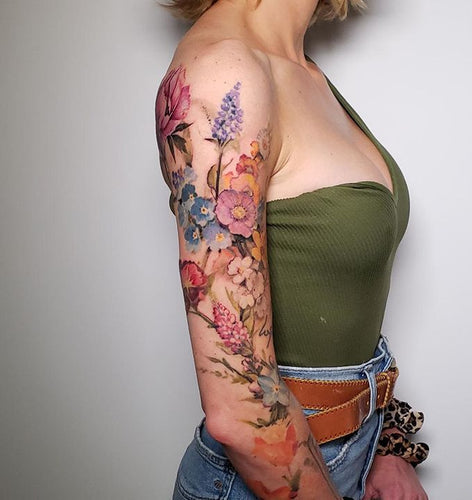The Transformative Power of Watercolor Tattoos
In the realm of body art, watercolor tattoos have emerged as a breathtaking medium of personal expression—a delicate dance of pigments that transcends traditional tattooing. Unlike conventional ink designs, watercolor tattoos blur the lines between skin and canvas, creating ethereal masterpieces that tell stories deeper than words ever could.
These fluid, painterly designs are more than mere decorations; they are emotional landscapes painted directly onto the human body. Each stroke represents a moment of healing, a brushstroke of personal transformation that captures the nuanced complexity of human experience.
The Art of Emotional Expression
Watercolor tattoos represent a revolutionary approach to body art. They don't just mark skin—they tell stories. The bleeding colors, soft edges, and dreamlike quality speak to the parts of ourselves that cannot be articulated through traditional means. They are visual poetry, emotional cartography mapped onto the most personal canvas we possess: our bodies.
1. Nature-Inspired Watercolor Designs: Connecting with the Natural World
Delicate Floral Watercolor Pieces
Nature has always been a profound source of healing and inspiration. Watercolor floral tattoos capture this essence perfectly—imagine a soft-edged rose that seems to bloom and fade simultaneously, its petals merging into the skin like a memory.
Design Inspirations:
- Lavender sprigs with ethereal purple gradients
- Cherry blossoms in soft pink and white
- Wildflower bouquets that appear to be painted with a gentle breath

Landscape and Scenery Watercolor Tattoos
Entire worlds can be contained within a single tattoo. Watercolor landscapes offer a portal to memory, emotion, and personal journey.
Captivating Concepts:
- Misty mountain ranges with layers of blue and gray
- Sunset horizons bleeding into skin tones
- Forest scenes that seem to breathe and move

Ethereal Animal Designs with Bleeding Colors
Animals have long been symbolic representations of our inner selves. Watercolor animal tattoos transform these symbols into living, breathing art.
Mesmerizing Designs:
- Wolves with fur that dissolves into abstract color waves
- Butterflies that appear to be mid-transformation
- Foxes with fur that melts into surrounding colors

2. Emotional Symbolism in Watercolor Art
Tattoos Representing Personal Growth and Transformation
Every watercolor tattoo tells a story of change. The very technique—colors bleeding and blending—mirrors the human experience of transformation.
Symbolic Design Themes:
- Phoenix rising through color gradients
- Lotus flowers emerging from watercolor waves
- Metamorphosing butterflies representing personal evolution

Mental Health and Healing Journeys
Watercolor tattoos offer a unique language for discussing mental health. They can represent healing, resilience, and the beautiful complexity of emotional experiences.
Healing Design Concepts:
- Brain illustrations with colors representing emotional states
- Abstract representations of anxiety and recovery
- Mandala designs symbolizing inner peace

Color Psychology in Watercolor Tattoo Choices
Colors aren't just visual—they're emotional languages. Each shade carries psychological weight:
- Blue: Calm, tranquility, healing
- Purple: Spirituality, transformation
- Green: Growth, renewal
- Pink: Compassion, self-love
- Teal: Emotional balance

3. Techniques and Styles: The Magic Behind Watercolor Tattoos
Understanding Watercolor Tattoo Techniques
Creating a watercolor tattoo is an art form that requires exceptional skill. Artists must:
- Master color blending
- Create smooth, seamless transitions
- Understand skin as a living, moving canvas
Traditional vs. Watercolor Tattooing
Unlike traditional tattoos with bold lines, watercolor designs:
- Lack definitive borders
- Use softer color gradients
- Appear more like paintings than illustrations

How Artists Create the Signature Watercolor Effect
The magic lies in:
- Layered, translucent pigments
- Purposeful color bleeding
- Minimal use of black outlines
- Advanced shading techniques
4. Body Placement Considerations
Best Body Areas for Watercolor Tattoos
- Shoulder blades: Large canvas for expansive designs
- Forearm: Perfect for smaller, detailed pieces
- Back: Ideal for landscape and large-scale art
- Ribs: Excellent for intimate, personal designs
Skin Tone and Color Interaction
Different skin tones interact uniquely with watercolor tattoos:
- Lighter skin: Colors appear more vibrant
- Medium skin: Softer, more muted tones
- Darker skin: Rich, deep color interactions
Preserving the Delicate Watercolor Aesthetic
- Regular moisturizing
- Sun protection
- Touch-ups to maintain vibrancy

5. Healing and Aftercare for Watercolor Tattoos
Specialized Care for Maintaining Color Vibrancy
- Use fragrance-free moisturizers
- Avoid direct sunlight during healing
- Follow artist's specific aftercare instructions
Protection from Sun and Fading
- High SPF sunscreen
- Cover tattoos in direct sunlight
- Consider touch-ups every few years
Touch-Up Recommendations
Watercolor tattoos may require more frequent touch-ups to maintain their ethereal quality. Consult with your tattoo artist about:
- Initial healing touch-ups
- Long-term color maintenance
- Recommended intervals between touch-ups

Conclusion: Your Body, Your Canvas, Your Story
Watercolor tattoos are more than art—they're a form of personal storytelling. They invite us to see our bodies as living canvases, our experiences as fluid and beautiful as the colors that dance across our skin.
Each design is a testament to human resilience, creativity, and the endless capacity for transformation.


Leave a comment